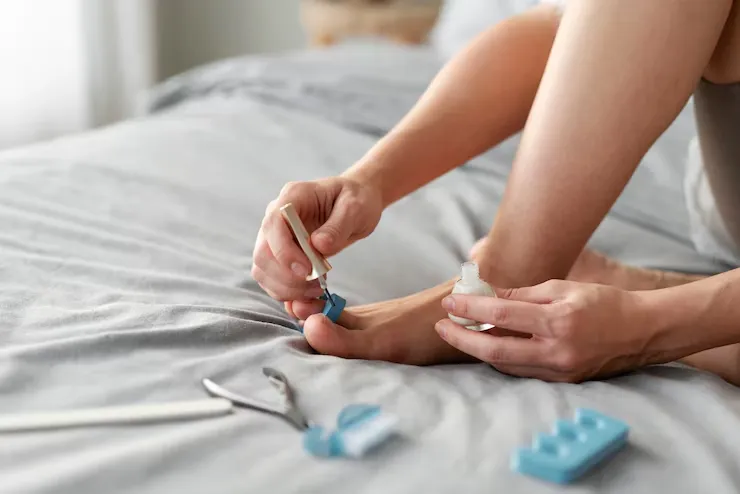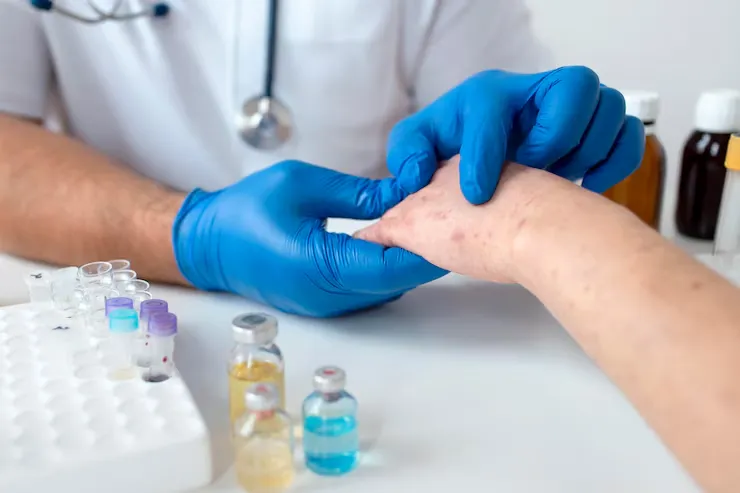
Key Takeaways
- Gangrene is the death of body tissue due to a lack of blood supply or severe bacterial infection.
- Common Symptoms include skin discoloration (pale, blue, black, or red), severe pain or numbness, swelling, foul odor, blisters, and coldness in the affected area.
- There are six main types: Dry, Wet, Gas, Internal, Fournier’s, and Necrotizing Fasciitis, each with distinct characteristics.
- Diabetes is a major risk factor, especially for diabetic foot gangrene.
- Treatment focuses on stopping spread, addressing the root cause, and may involve surgery (including amputation), antibiotics, or hyperbaric oxygen therapy.
- Amputation is a life-saving measure when gangrene is severe and uncontrolled. Early detection and treatment are crucial to prevent devastating outcomes.
The human body is the most interesting piece of engineering we know. However, this same marvel can harbour silent threats within. Gangrene acts on our healthy tissue, turning it into a mass of dead, decaying matter. This grim condition gradually becomes life-threatening if left untreated. It happens as the body tissue dies if blood fails to reach it, and a severe bacterial infection can occur.
Gangrene disease very often leads to devastating outcomes and, eventually, amputation becomes a necessary step to save a limb or even a life.
This comprehensive guide explores what gangrene is, its different types, common causes, crucial symptoms to watch for, and the role of amputation in treatment.
What is Gangrene? Understanding Tissue Death
Gangrene or necrosis is the death and decay of cells in specific body areas. It occurs with a lack of blood supply or a severe infection leading to obstruction in the supply of oxygen and nutrients to the area, causing Gangrene disease. This progressive decay can spread fast if treatment is not available initially. Gangrene symptoms initially show up in fingers, toes, and limbs. However, symptoms may occur in muscles and internal organs.
Gangrene Symptoms: 7 Warning Signs You Must Know
They say a stitch in time saves nine. This is true in the case of Gangrene, so it pays to know the initial signs of Gangrene for timely treatment. Knowing the following gangrene symptoms can make the difference between life and death:
- Skin Discolouration: The skin colour in the gangrene-affected area changes, becoming pale and then blue, purple, black, or red.
- Numbness or Pain: The infected might undergo severe pain in the affected area. The area may also become numb as the nerves die.
- Swelling: The infected area becomes swollen.
- Odour: A stinking odour is present with a smelly discharge.
- Blisters or Sores: Blisters and sores have pus.
- Coldness to Touch: The affected part feels cold..
- Feeling Sick: The individual is feverish due to infection.
Seeing any of these signs?
Don’t wait. Get medical help right away.
Quick treatment can make all the difference; it could save your limb, and even your life.
What Causes Gangrene? Common Medical Triggers
There are several causes of Gangrene. Let us look at the common reasons:
- Lack of Blood Flow (Ischemia): Sometimes, the hardening of the arteries (atherosclerosis), or peripheral artery disease (PAD), and significant injuries gradually deprive the affected area of oxygen and blood.
- Infections: Bacterial infections may breed toxins, killing tissue and blood vessels.
- Underlying Medical Conditions include diabetes, poor immune systems (e.g., HIV/AIDS, cancer), and extended immobility.
- Raynaud’s Phenomenon: This condition obstructs blood supply towards toes and fingers and causes gangrene.
- Injury: Wounds due to accidents or burns.
- Traumatic Wounds: Severe wounds, surgery or other reasons leading to excessive blood loss.
What are the Primary Risk Factors for Gangrene?
According to medical research, around 1 in 100 adults over 50 years old may develop Gangrene. Increasing age poses a higher risk of developing Gangrene due to various risk factors:
- Smoking: It creates lung problems and poor circulation, and increases the risk of Gangrene disease.
- Compromised Immune System: People who have underlying conditions like HIV/AIDS, cancers, or take medications are more at risk.
- Advanced Age: Ageing individuals face more risk due to age-related issues and comorbid conditions.
- Obesity-Related Diabetes: Obesity-related diabetes may be a factor.
- Injury or Surgery: Recent trauma or surgical procedures may increase the risk.
- Alcohol abuse: It often leads to Gangrene.
Types of Gangrene: 6 Severe Forms You Should Know
There are six types of Gangrene with different characteristics:
- Dry Gangrene: This type of Gangrene occurs when the blood supply to the area faces blockage. Symptoms appear in the toes and fingers. Individuals with diabetes and atherosclerosis are more at risk. Affected area appears wrinkled, and the dry skin becomes red to brown to black.
- Wet Gangrene: Bacterial infection causes wet Gangrene that leads to the death of tissue in the area., Infection can occur from severe burns, frostbite, or injury. Wet Gangrene develops fast and is life-threatening. This type of Gangrene is foul-smelling, with blisters and a swollen, wet appearance.
- Gas Gangrene: Clostridium, a particular bacterium, causes gas gangrene, or gas in the tissue. This Gangrene arises from bacteria-infected wounds. The painful condition shows a peculiar swelling, and the individual feels a crackling sensation. Treatment is essential.
- Internal Gangrene: Internal gangrene occurs when any internal reason obstructs blood flow to the internal organ. Gallstones, diseased intestines, or a hernia may cause internal gangrene. It needs urgent medical intervention.
- Fournier’s Gangrene: This type of gangrene is found in the genital or urinary tract area, and it is due to infections and is common in men.
- Necrotising Fasciitis: This severe bacterial infection causes soft tissue to die. It is also called “flesh-eating disease.”
Dry Gangrene Causes & Symptoms
- Cause: Dry gangrene is caused by blood flow blockage to the area, even without any infection. It affects people with chronic conditions that narrow arteries, including diabetes and PAD.
- Appearance: Dry Gangrene wrinkles the skin, which changes to dark, black, or brown.
- Feel: The tissue feels cold and numb, with a clear separation line from healthy skin.
- Spread: Develops slowly over time, often affecting extremities like fingers and toes.
- Odour: Typically has no foul smell.
- Fluid and Pus: No fluid or pus is present.
- Risk of Sepsis: Lower risk, as there’s no widespread bacterial infection.
Wet Gangrene Causes & Symptoms
- Common Causes: Injuries, burns, or frostbite are the leading causes. People with lower or compromised immune systems or diabetes are more at risk.
- Appearance: Gangrene-hit areas become swollen, moist, and marked with blisters. The affected parts become brown, purple, or greenish-black in colour.
- Feel: The individual experiences pain, and the skin is soft and swells up.
- Spread: Wet Gangrene spreads fast and becomes life-threatening in no time.
- Odour: Presence of foul smell.
- Fluid/Pus: Open blisters release pus and fluid.
- Risk of Sepsis: Maximum risk of sepsis.

Can Gangrene Cause Death? How Fast It Spreads
Gangrene-related deaths depend on the type, spread, location, and the patient’s physical condition. Gangrene creates sepsis and may lead to death for lack of treatment. Dry Gangrene shows slower progress; however, treatment is essential to stop infections.
Medical intervention depends on the reasons, including:
- Extent of the spread: How much tissue is affected.
- Treatment: Delayed or absent treatment rapidly increases fatalities. Dead tissue can quickly spread to more areas hourly.
- Affected area: Gangrene in vital organs is more immediately life-threatening.
- Health of the person: Underlying conditions can complicate recovery.
Delayed treatment, or lack of it, leads to fatalities. Moreover, dead tissue may quickly take over more area per hour.
Gangrene Early Stages
Gangrene stages may be marked by their progress. The initial stage shows a lack of blood flow or initial ischemia, which causes tissue death. Then we can see the stage where Gangrene develops, infection, and decay. Gangrene is hardly noticeable when it starts; however, small indications of changes in skin temperature, such as cold skin, discoloured areas, numbness, or tingling sensations, show hidden infections.
Gangrene Infection And Bacterial Component
Gangrene infection spreads very fast due to bacterial growth in dying tissue and toxins begin damaging healthy tissue and blood vessels. This destructive process boosts infection risk and spreads through the blood flow, forming sepsis.
Why Diabetic Foot Gangrene Is A Major Concern?
Diabetes is the main risk factor that leads to diabetic foot gangrene. High, unchecked blood sugar levels behind nerve and blood vessel damage are at the root of diabetic foot gangrene. Blood flow and sensation in the feet is obstructed. Consequently, minor cuts or sores are more likely to get severely infected and develop into Gangrene.
It is common practice to refer to infected ulcers in diabetic individuals as ” Sugar Gangrene.” Therefore, if you notice a sweet-smelling odour, it may indicate sugar gangrene and seeking proper treatment immediately is the appropriate decision. Diabetic individuals must have periodic foot checkups along with other necessary tests.
Key Differences Between Necrosis and Gangrene
There are some subtle differences between necrosis and Gangrene.
- Necrosis: Refers broadly to the irreversible death of cells or tissues, regardless of the cause.
- Gangrene: Is a specific type of necrosis that happens if there is obstruction to blood flow to tissues, or severe bacterial infection and decay.
How to Stop Gangrene from Spreading?
Gangrene can be prevented:
- Manage diabetes: Control your blood sugar levels, regularly check your hands and feet for any sores or infections, and go for regular checkups.
- Maintain a Healthy Weight: Obesity may lead to diabetes and place stress on the arteries. Slowing the supply of blood, boosting infection risks and stopping wounds from healing.
- Avoiding smoking and tobacco use: Damages the blood vessels.
- Hygiene: Keep the sores and wounds clean.
How is Gangrene Treated?
Several types of treatments can stop the spread of Gangrene:
- Surgical Procedures: You can surgically remove the infected tissue to prevent further spread or infection.
- Antibiotics: Take prescribed antibiotics for wet and gas Gangrene to end the bacterial infection.
- Improved Blood Flow: If the patient is healthy enough to undergo vascular surgery (like bypass or angioplasty), it can restore blood flow.
- Hyperbaric Oxygen Therapy (HBOT): The affected person can breathe pure oxygen in a controlled area to boost blood oxygen levels and fight infection.
Dry Gangrene Treatment
Dry gangrene treatment emphasises treating the root cause and boosting blood flow; the dead tissue often falls off naturally. However, surgery is essential in case of infection.
Wet Gangrene Treatment
Wet gangrene treatment involves surgically removing the necrotic infected tissue. The individual is also given significant antibiotics, which help to control the infection and prevent sepsis.
Why is Amputation for gangrene a life-saving measure?
Amputation for gangrene is an extreme step to save an individual from a life-threatening situation when you cannot treat Gangrene and the threat of sepsis.
Why Check Symptoms of Amputation After Surgery?
Careful monitoring is essential after a limb is amputated, as there may arise excessive bleeding complications and extreme pain, or the patient may not improve or respond to treatment. There may be secondary infections, fever, swelling or pus formation.
Life After Gangrene Amputation
We understand that picking up the pieces of your life after Amputation is not easy. Therefore, individuals need rehabilitation to cope with life after an amputation. If you are facing any such situation, you can consult prosthetics and clinicians for regular physical therapy, occupational therapy, and prosthetic fitting to restore mobility and independence. You may also need considerable psychological support to adapt to the physical and emotional changes.
Conclusion
Surviving Gangrene and living after an amputation is challenging; however, being aware and having access to necessary medical support can make the difference between life and death. Now that you have the basic information about the hidden threat of Gangrene, its types, and the crucial role of treatment, including Amputation, which can save lives.
You can make decisions for yourself and your loved ones if needed. If you or a loved one faces life after Amputation, assistive technologies are available to help regain mobility. The KARE Prosthetics & Orthotics India team is always ready to provide necessary care and expert guidance.

Frequently Asked Questions
Prosthetics restore mobility for individuals who have lost limbs due to Gangrene. Today, technologically superior prosthetics can copy natural movement and function of the missing limb. Therefore, they play a crucial role in improving the quality of life for individuals and enabling them to perform daily tasks confidently. Kare Prosthetics & Orthotics is playing a commendable role in this field by bringing quality prosthetics within reach in India.
The medical bills for critical treatment procedures, including Gangrene and Amputation, are staggering. Therefore, it becomes highly crucial to consider early medical intervention. Apart from being expensive, the delay might cost you a limb.
Complications of Amputation may be several, including
* Infections, severe blood loss, blood clots, and extreme pain.
* It is common for individuals to feel Phantom limb pain or a feeling of pain in the cut-off limb, delay in healing, nerve growths, depression, and face issues with mobility.
No. You cannot reverse Gangrene; there can be no revival of dead tissue. However, timely treatment will help prevent gangrene progression.
No. Gangrene is not contagious. However, the bacteria can spread to others through open wounds, and infection may depend on the person’s poor physical health.
No. Unfortunately, the revival of tissues that die due to Gangrene is not possible. But, treatment can further stall the development of Gangrene and eliminate the root cause.



